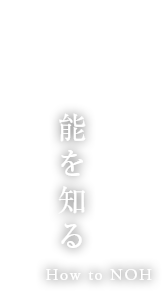能面についてAbout "Noh" mask
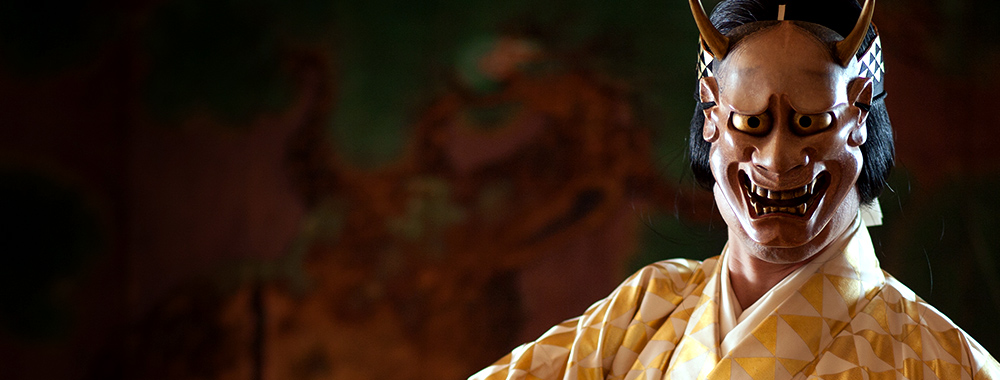
能面(面=おもて)は、能を演じる際に主にシテ方が顔につけます。
古くは能面が宗教的意味を持っていたので、宗教的意味がない場合は仮面を原則としてつけず、また祭具としして使用された能面は焼くか流すのが原則だったのではないかと考えられています。
能の発展と共に、能面にも形式や約束事が多く用いられるようになり、眼の色、面の色、眉や口の形、骨格などに多くの情報が組み込まれ、写実と抽象の兼ね合った幽玄な美的表現を強く表すようになります。
室町時代末期には今日の能面の基本的なものはすべて完成し、また世襲の面打の家も生まれました。江戸時代になると、多種多様な面の中で優れたものを「模作」し、新たな工夫が施されるようにもなります。
実際に舞台で使用されている能面は、同じ種類の能面であっても、時代や作者の違い、舞台での使用頻度などにより、それぞれに表情や性格があり、同じものは一つとして存在しません。
基本型は60種類位、今日では200数十種類が存在すると言われています。
大きく分類すると、翁系の面、老人の面、鬼神の面、女面、怨霊の面、男面の六種類に分類する事ができますが、研究者により分類方法には若干の違いが存在します。
また実際に使用する際には、能面の分類が絶対的なものではなく、各々の能面の持つ顔立ち・品格・雰囲気や演目との相性、衣装との相性など総体的な判断を演者が行い決定します。
なお、能面をつけず素顔の場合を「直面(ひためん)」といいますが、この場合も表情で喜怒哀楽を表現する事はなく、能役者の顔そのものが「面」となります。
Noh masks, called “Omote” in Japanese, are worn by the Shite role when Noh is performed.
In the olden days, Noh masks carried a religious meaning so people didn’t wear them in situations which didn’t have religious meaning. Also, it is said that it was fundamental for the Noh masks that were used as rituals equipment to be burned down or flown into the river.
As the Noh developed, many forms or rules were added to the Noh masks and a lot of symbolism was put into in the color of the eyes, the color of the masks, the shape of the eyebrows or mouth and the bone structure, then they started strongly expressing the profound expression of beauty which balances the realism and abstract.
By the end of the Muromachi era (15th century), the basics of today’s Noh masks had been all completed, and the hereditary mask artisans were born. In the Edo Era (17th to 18th century), the artisans would emulate the outstanding mask out of many varieties and a lot of thought was put into it.
The actual Noh masks that are used on the stage, even if they are put into the same category, have different facial expressions and characters in each depending on the difference of the era or the playwright, or the frequency of usage on the stage, and thus there isn’t even a single same pair.
Today, it is said that there exists about 60 basic types and two hundred and some tens of Noh masks.
When classifying them, even though they could be categorized into six types such as the masks of the Okina group, old man, demon, women, vengeful ghost and men, there is a slight difference in the way of categorizing depending on the researcher.
In addition, when the masks are actually used, the classification is not absolute and the actor decides the overall judgment such as the facial features, dignity, impression, the compatibility to the play and the compatibility to the costume each mask has.
Furthermore, it is called “Hitamen” when the actor performs without the Noh mask, instead with his real face. The actors don’t express emotions with their facial expressions in this case as well, and therefore Noh actors’ faces themselves will become the “masks.”
-

翁面Mask of Okina
舞台
白式尉(はくしきじょう)「翁」Play/Performance
Hakushikijou "Okina"能面の中ではきわめて特殊な形式で、もっとも神聖視されています。
老人の面と同様「老人」ではあるのですが、特に「能にして能にあらず」と言わ れる能、「翁」で使用される面の事を指します。また、能面の中で最も古くに作られ、他の能面と違った様式を備えているのも一つの特徴です。
笑いをたてた肉づきのよい表情で、切顎(下顎が切り離されている)、「ぼうぼう眉」のふくよかな顔をしています。それは寿詞をのべることを象徴的に表現したものともいわれます。翁が何者を表しているかは諸説がありますが、土着の神の猿楽化とも、寺院における呪師芸の猿楽化ともいわれています。This is an extremely special style among Noh masks and it is the most sanctified. Even though these masks are also “old man” as well as the masks of old man, it is referred to the masks used in “Okina” which in Noh is described as “It is Noh, but it’s not really Noh.” In addition, they were crafted in the oldest period, and their carrying a different style compared to the other Noh masks is also one of their characteristics. Its facial expression is smiley and well-fleshed, the bottom jaw is separated, and it has a plump face with bushy eyebrows. It is said to be the mask that symbolically expresses the celebrational speech. Though there are various opinions about who Okina represents, it is said to be an indigenes god or arts at temples turning into Sarugaku. Sarugaku refers to Gigaku—an ancient musical in which actors perform along with music wearing masks— which was passed on from China, and/or Sanraku—magic, acrobatics, conjuring, dance and so on—that became popularized with various arts, and especially what developed to comedic art or sketch.
-
白式尉Hakushikijou

-
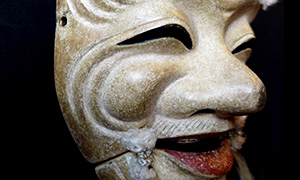
-
-

尉面じょうめんJoumen
舞台
三光尉(さんこうじょう)「国栖 前シテ」など
朝倉尉(あさくらじょう)「竹生島 前シテ」など
小牛尉(こうしじょう)「氷室 前シテ」などPlay/Performance
Sankoujou "Kuzu Mae Shite" etc.
Asakurajou "Chikubushima Mae Shite" etc.
Koushijou "Himuro Mae Shite" etc.老人の面を能では尉面と呼びます。特徴としては、結髪し頬骨が高く、瘦せ形で老人らしく見せますが、歯は整っています。
尉の中にも小牛尉、三光尉など各種ありますが、各種名称をもつ尉には造形上の特徴があり、それぞれが面の性格を表しています。The masks of old man are referred as joumen in Noh. Its characteristics are tied hair with high cheek bones and though they appear to be old man-like with their thin figure, the teeth are straight. There are all kinds such as Koushijou or Sankoujou in Jou, but jous that have their own names have design characteristics and each represents the masks' personality.
-
皺尉(しわじょう)Shiwajou

-
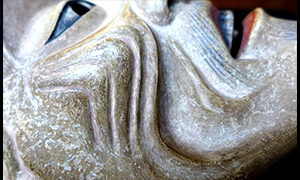
老いた植物の精霊、老体の神などに用いられます。皺が深い事が名前の由来であり、皺は老いを表すと共に、人知を超えた長い年月を生きてきた証でもあります。穏やかに、内省的な眼差しで舞を舞う老人です。
It is used for the senile spirit of plants, the gods of senile body and so on. The origin of its name is its deep wrinkles which represent the age and it is proof of long life which exceeded the human understanding. It is the old man who dances peacefully with an introspective look in his eyes.
-
-
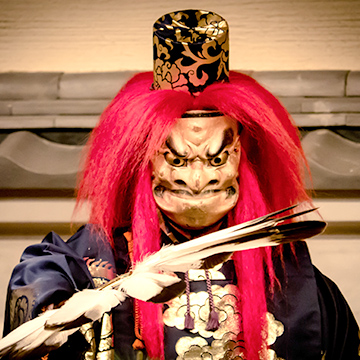
鬼神の面Mask of Demon God
舞台
大癋見(おおべしみ)「鞍馬天狗 後シテ」など
不動(ふどう)「国栖 後シテ」など
黒髭(くろひげ)「竹生島 後シテ」などPlay/Performance
Oobeshimi "Kuramatengu Ato Shite" etc.
Fudou "Kuzu Ato Shite" etc.
Kurohige "Chikubushima Ato Shite" etc.天狗や神、龍、人間に害をなす鬼など多くの種類があります。
鬼というと角があるというのが一般的ですが、能面の鬼神にはありません。また牙のある面も少数です。There are many kinds such as tengu (a legendary creature said to be a supernatural monster or sometimes a god, who learns Buddhism but uses black arts), god, dragon, and demon who harms human. When it comes to demon, it's generally thought that it would have horns, but the Noh mask of demon god doesn't have any. Also there are a small number of masks that have fangs.
-
大飛出(おおとびで)Ohtobide

口を開け、目を飛び出すように見開いた、威風堂々とした神として登場する面です。全面金泥彩色で目に鍍金銅板が嵌められ、威圧感が強調されています。With the mouth open and wide-opened eyes as if they pop out, this is a mask that appears as a god with full-flown dignity. It is fully gold-painted and plated copper is put in the eyes and thus the dignity is emphasized. -
小飛出(ことびで)Kotobide
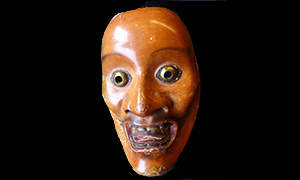
主に地上を軽快に疾駆する神霊を表します。 飛出と癋見は一種の対照にあり、「阿吽」をなしています。「鵺」「小鍛冶」「殺生石」などに使用されます。This mainly represents a spirit that lightly roams the land. Tobide and beshimi contrast each other in a way and they create "A-un.”* It is used in "Nue""Kokaji" "Sesshouseki"and so on. -
小癋見(こべしみ)Kobeshimi
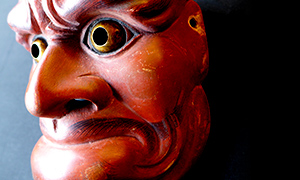
「癋見」とは「口をへしむ」からきており、下顎に力を入れ、口を真一文字に結んで見据えています。地獄の鬼の役などに用い、赤味の強い彩色が特徴です。The word "Beshimi" derives from the Japanese word "heshimu" and it means fixing the jaw with the lips tightly closed and staring eyes. It is used for the role of demon from hell and a strong red color is its characteristic. - *"A-un" is one of the Buddhist chants. "A" is the first sound you create with the mouth open, and "un" is the last sound you create with the mouth closed. Therefore, those two words are considered to represent the beginning and the end of the universe respectively.
-
-
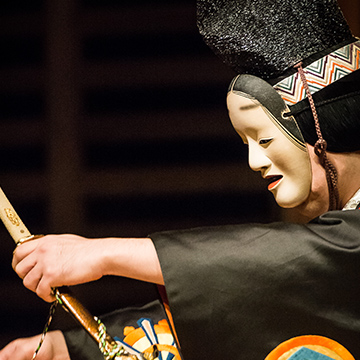
女面Mask of Woman
舞台
増(ぞう) 「巴」など
小面(こおもて) 「杜若」などPlay/Performance
Zou "Tomoe" etc.
Koomote "Kakitsubata" etc.喜怒哀楽の表情が曖昧である能面の表情を「中間表情」といいますが、女面はその代表格といえます。年齢の別、品格の別から「小面」、「増」、「深井」、「姥」、「老女」などがあります。
The mask's facial expression, whose emotional expression is ambiguous, is called "neutral facial expression" and the mask of woman is the representative of it. There are "Koomote," "Zou," "Fukai," "Uba," "Roujyo,"and so on depending on the age and dignity.
-
小面(こおもて)Koomote
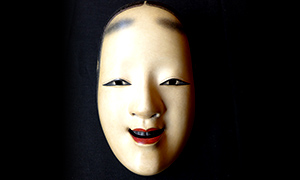
能面といえば、この面をまずこの想像する方も多いかと思います。額から頬にかけて三本平行に毛が描かれているのが特徴です。小面の「小」には「可憐、かわいい」などの意味があり、女面の中では最も若い女性を表している面になります。There are probably many people who would imagine this mask when it comes to Noh masks. The three hair line is drawn parallel from the forehead to the cheeks. Koomote's "Ko"means "lovely" or "pretty" and so on, this is the mask that represents the youngest female among the mask of woman. -
深井(ふかい)Fukai
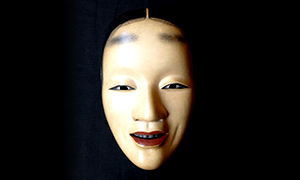
中年女性を表した面です。年齢を積み重ねて老いた造形が、口元のえくぼ状の皺や少し窪んだ目に読み取る事ができます。人生経験を重ねた落ち着きと心情の深さ、憂いを含む表情など「深」という意味から「深井」という名称がついたと言われています。This is a mask that represents a middle-aged woman. The aged formation is seen in the dimple-like wrinkle around the mouth and the sunken eyes. Because of its calmness from the layers of life experiences, the depth of emotions and the wistful facial expression, it is said the mask was named "Fukai" with the meaning of depth. (Fukai also means "deep" in Japanese.)
-
-
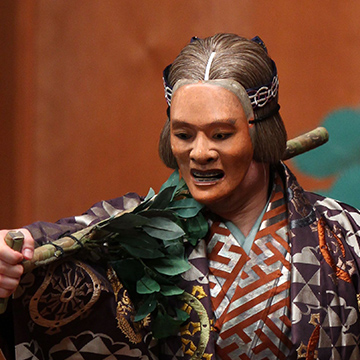
怨霊の面Mask of Vengeful Ghost
舞台
山姥(やまんば)「山姥 後シテ」など
般若(はんにゃ)「道成寺 後シテ」など
三日月(みかづき)「船弁慶 後シテ」などPlay/Performance
Yamanba "Yamanba Ato Shite"etc.
Hannya "Dosyouji Ato Shite" etc.
Mikazuki "Funabenkei Ato Shite" etc.戦で無念の最期をとげたり、嫉妬に狂う女性が死して霊となって祟るといった種類の面、人ならざるものや、人ならざるものになりかけている類の面になります。男の怨霊には、「怪士(あやかし)」、「河津(かわず)」などがあります。
This is a kind of mask that represents something that is not a human, something that is becoming a non-human, or a woman who dies with indignity in the battle or who dies after going insane with jealousy and becomes a cursed spirit. There are "Ayakashi","Kawazu" and so on in male vengeful ghost.
-
山姥(やまうば、やまんば)Yamanba
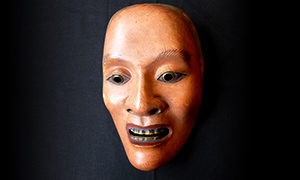
怨霊の面、女面、どちらの分類にするかは解釈により異なる面です。能の山姥は、風貌怪異ですが化物ではなく、深山幽谷の主であり、宇宙の象徴ともいえる超自然的で神秘的な存在です。落ち着いた赤味のある肌と白髪、鍍金銅板が嵌められた鋭い表情の眼が特徴です。This is a mask categorized differently depending on the interpretation, whether it belongs to the mask of vengeful ghosts, or the mask of a woman. Yamanba in Noh is not a monster but it is a lord in the deep mountain and valley and a supernatural mystical being that could be a symbol of the cosmos, even though its appearance is odd. The subdued reddish skin, the gray hair, and the eyes of plated copper that are put in are its characteristics. -
般若(はんにゃ)Hannya
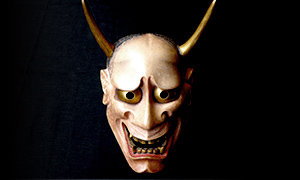
般若や生成(なまなり=般若になりかけの小さな角の生え始めた面)は、鬼面の蛇類とも分類されますが、これは鬼神の面と異なり、嫉妬や怨み、悲しみといった女性の感情から生まれる人間の鬼の表現となっています。恐ろしくも悲しい人間の内面に棲む「鬼」の執心の凄まじさを造形にしています。Hannya or Namanari (a mask,that is almost becoming Hannya, whose horns are beginning to grow) are categorized in the snake group of the demon mask but this is different from the mask of demon god. Instead it represents a human's demon that is born from female feelings such as jealousy, grudge, and sorrow. The fierceness of obsession of the horrifying but sorry demon that inhabits inside of human is designed.
-
-
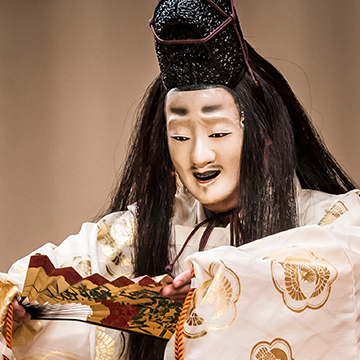
男面Mask of Man
舞台
中将(ちゅうじょう)「清経」などPlay/Performance
Chujyou "Kiyotsune" etc.女面に比べて、身分や状況の違いによって作り分けられている事が多いのが男面の特徴です。武将、公達、幽霊、男神、童子など種類も多く、特定曲に使用する特殊面が多いのもその特徴です。
Compared to the mask of woman, it is the characteristic of the mask of man to be often separately made by the difference of the status or the circumstances. There are many kinds such as samurai, nobleman, ghost, god of man, and child. It is also its characteristic that there are many special masks that are used for specific music.
-
平太(へいだ)Heida
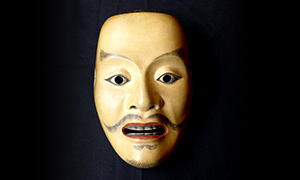
日焼けした勇猛な武将の表情の面です。勝ち戦を題材とした能「勝修羅」の能のみに使用されます。This is a mask of the facial expression of a tanned valiant samurai.
This is used only in Noh "Kachishura" whose theme is a triumphant battle. -
中将(ちゅうじょう)Chujyou
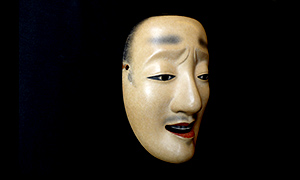
美男の代名詞とされ、「伊勢物語」の主人公と同一視されていた在原業平を模した面です。端正で教養と気品のある貴族的な顔立ち、眉間の皺から漂う哀愁により、「融」、「清経」などの演目に使用されます。This is a mask that imitated Narihira Ariawarano, who was considered a synonym to a handsome man and who was identified as the protagonist of "Tales of Ise". With gracious and aristocratic facial features with culture and sophistication, and the sorrow that drifts from the wrinkle between the eyebrows, is used for performances such as "Touru" or "Kiyotsune" and so on. -
邯鄲男(かんたんおとこ)Kantan Otoko

眉根を寄せ、人生に懊悩する哲学青年「盧生」の面差しを表します。盧生は尊い仏道の師を求める旅の途中、邯鄲の里で不思議な枕を借りて床に就きます。盧生は帝となり50年の栄華を過ごしますが、それはすべて夢、食事ができるまでのほんの短い間のことでした。悟った盧生は心穏やかに故郷に帰っていきます。This mask shows the facial feature of a philosophical boy "Rosei"* who agonizes about life with frowning eyebrows. Rosei borrows a wondrous pillow in the village of Kantan** on the way of a trip to quest for a noble master of Buddhism and goes to bed. Rosei becomes the emperor and spends 50 years of glory but it is all just a dream and it was just a short moment till the meal was prepared. Realizing this, Rosei goes back to his hometown with a calm heart. -
猩々(しょうじょう)Shoujou
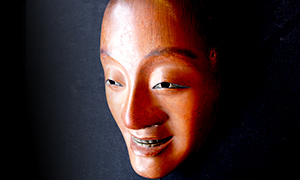
猩々は、満月の夜に海中より現れ、浜辺で酒を舐めつつ波と舞い戯れるという、酒好きの妖精です。水中から上がったばかりで濡れ乱れたかのような髪の毛に赤ら顔で、能面には珍しく、微笑んだ少年風の顔です。祝言性の高い「猩々」専用の面です。Syoujou is an alcohol-drinking fairy that appears from the sea on the night of a full moon and plays and dances with waves while licking alcohol on the beach. The blushing face with wet hair as if it just got out of the water is rare in Noh masks, and it has a smiley boy-like face. This is a mask exclusive to "Shoujou" that has a high celebrational address nature.
*Rosei
He is the protagonist of a fantasy novel "The World Inside a Pillow" made in China around the 9th century. "The World Inside a Pillow" is known for its "a vanished dream", a saying meaning prosperity and decline are just a dream. "
**The village of Kantan indicates a city in Zhao, China in the era of battle and it is located in the current south of Hebei Province. -
林家略年表History of The Hayashi's
| 1625 | 寛永2年 | 林九兵衛の次男、千本三条へ分家し、林喜右衛門と名称し、謡を以て生業とする。 二代目までの歴史的検証が出来ず、三代目が初祖ではないかという説が有力。 |
|---|---|---|
| 1671 | 寛文11年 | 3代林喜右衛門(玄融)、福王家(服部宗巴)へ入門、謡を習得する。 |
| 1694 | 元禄7年 | 服部宗碩が京都で隠居、素謡の教授を始める。 京都五軒家は岩井、浅野、薗、林、井上をいう。 |
| 1708 | 宝永5年 | 3代玄融他5名、13代観世滋章の直門となる。 |
| 1720 | 享保5年 | 玄融他2名、江戸へ行き、観世家の直弟となる。 「素謡家の始とす。」 |
| 1721 | 享保6年 | 3代玄融、10月17日南岩戸山町東側に住む。 |
| 1723 | 享保8年 | 4代玄庭、林喜右衛門襲名。 観世家に2度修行に赴き、御本丸にて御能仕舞數番勤める。 玄融は落髪、「関寺小町」を拓くことを14世観世清親から許される。 |
| 1760 | 宝暦10年 | 5代玄好、林喜右衛門襲名。 池田、大津、若狭、備前に多くの社中あり。 |
| 1780 | 安永9年 | 6代玄乗、林喜右衛門襲名。 |
| 1783 | 天明3年 | 7代玄先、林喜右衛門襲名。 |
| 1788 | 天明8年 | 天明の大火によって居宅焼失。(京都市街地の8割が焼失。) |
| 1818 | 文政元年 | 8代玄章、林喜右衛門襲名。 |
| 1839 | 天保10年 | 9代玄篤、林喜右衛門襲名。 玄章の社中、玄篤の社中共々多く、益々盛んとなる。 |
| 1864 | 元治1年 | 禁門の変により家屋焼失。同年假家建設、稽古を始める。 |
| 1868 | 明治元年 | 10代目玄忠、林喜右衛門襲名。 士農工商の「士」として身分、俸給を世襲していた能楽の役者は明治維新によって 存続の危機を迎え、多くの者が困窮、廃業することとなる。 |
| 1872 | 明治5年 | 10代玄忠、一時業を休む。 |
| 1875 | 明治8年 | 10代玄忠、月次会を再び催す。 |
| 1876 | 明治9年 | 4月4日岩倉具視邸にて天覧能が開催され、天皇がご覧になる。(能楽復興の第一歩) |
| 1881 | 明治14年 | 新町岩戸山町の旧宅地に普請、12月に引き移る。 この頃京都にも能楽復興の様子が著しく表れる。桂御所、本願寺などで催しが度々あった。 |
| 1883 | 明治16年 | 10代玄忠、功労があったという事で謡皆伝の免状を付与される。 当代より素謡専門ながら一方に立方をも勤める事となる。 |
| 1909 | 明治42年 | 11代幽玄、兵役に服務。 |
| 1914 | 大正3年 | 11代幽玄、林喜右衛門襲名。 |
| 1920 | 大正9年 | 2月1・2日、舞台披きの能を張行。 以来、定期能楽会を組織。 |

